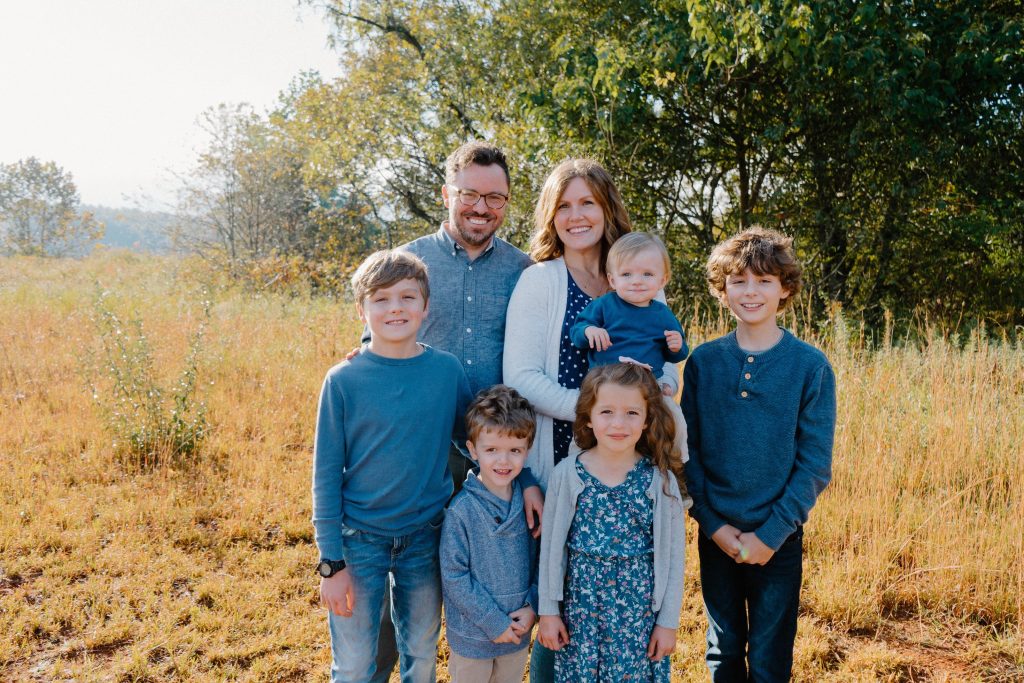How a mother’s struggle with a rare condition, fetomaternal alloimmunization, drove her to advocate for proper care in her future pregnancies and for other mothers in need.
Bethany Weathersby had two routine pregnancies and two healthy children, Liam and Asher.
Bethany and her husband were looking forward to growing their family, however, just nine weeks into her third pregnancy, she was diagnosed with fetomaternal alloimmunization – a sensitization to foreign antigens which stimulates the production of maternal antibodies. In Bethany’s case it was exposure to a rare blood type during her second pregnancy that caused her immune system to trigger her antibodies to cross through the placenta and attack her fetus’s red blood cells. By the time her unborn baby, who she and her husband had named Lucy, was treated with an intrauterine blood transfusion, Lucy was already severely anemic as a result of hemolytic disease of the fetus and newborn (HDFN) and lack of monitoring. Lucy did not survive.
Fetal Health Foundation champion steward partner Janssen Pharmaceutical Companies of Johnson & Johnson spoke with Bethany about this heartbreaking experience and how it set her on a journey to find specialized medical care so she could successfully carry another child and she and her husband could complete the family they had always wanted. She then made it her mission to ensure that other mothers diagnosed with maternal alloimmunization had education about the risks of the disease and knew the steps for proper medical care and treatment, so that their babies could survive HDFN.
Tell us about your diagnosis with fetomaternal alloimmunization. How did learn you have the disease?
Fetomaternal alloimmunization was discovered during a routine first trimester blood test nine weeks into my third pregnancy. My doctor told me that I had anti-Kell antibodies in my blood. Kell is a rare blood type inherited from paternal genes.(1)
My husband carries the Kell antigen, which was passed on to my second son. Though I had a normal pregnancy and he was born healthy, my doctor explained that my immune system had developed anti-Kell antibodies during the labor and delivery process. Incompatible blood types between mothers and babies can lead to hemolytic disease of the fetus and newborn (HDFN).(2)
Though HDFN would not affect my health, my body’s immune response was extremely risky for my third baby. If Lucy had this blood type, my antibodies would attack and destroy her red blood cells and she could become anemic and very sick.(2)
I went home and poured myself into research, but I found very little information online, apart from a couple archived discussion groups among mothers.
What followed your diagnosis with fetomaternal alloimmunization?
I found out that I had an extremely high antibody titer (level) and was referred to a maternal fetal medicine practice where a doctor advised that a fetal middle cerebral arterial (MCA) Doppler ultrasound would assess how quickly blood flows through the middle cerebral artery of my baby’s brain in utero.(3) If her blood was flowing too fast through her brain, it would indicate anemia.(3) The doctor said the MCA would be done at week 22 of my pregnancy. However, I had read that fetal anemia can happen much earlier than that. I asked my doctors to consider proactive monitoring and treatments such as plasmapheresis, IVIG and early MCA scans but they insisted that they weren’t necessary.
At this point, I felt anxious and afraid of what was happening. I didn’t have experience in advocating for medical care, but as a mother you’ll do anything for your children, so I pushed to get the MCA scans sooner. At my 18-week appointment, I asked my doctor again to please monitor my baby for fetal anemia and this time when they refused, I told the doctor I wasn’t leaving the office until I had the MCA scan. They finally agreed to do the scan which confirmed that Lucy was severely anemic and now showed signs of fetal hydrops as a result of the untreated anemia.
How was your baby treated for HDFN?
The day after the MCA ultrasound, my doctors conducted an intrauterine blood transfusion (IUT), a procedure considered relatively safe, though it can carry some complications.(4) IUTs come with higher risks when they are performed at early gestations or on a baby who shows signs of fetal hydrops. A week later, I had another MCA ultrasound that showed Lucy was even more anemic and now had heart damage. The next day as the doctors were preparing to attempt a second IUT, we watched on the ultrasound as Lucy’s heartbeat slowed down, then eventually stopped. We were devastated.
We were further brokenhearted to learn that fetomaternal alloimmunization usually worsens with each pregnancy, putting all of our future babies at risk unless they had my blood type. My husband and I had dreamed of having a big family. It was a very dark time for us.
You didn’t give up. Tell us about how your family has since grown.
I couldn’t give up hope. We had this deep need for more children. I felt that with the right doctors and the right treatments, we could have the big family we had always wanted. Through my online research, I found an expert in HDFN, Dr. Ken Moise, who taught me so much about the disease. My husband and I decided to try again even though it was risky.
I got pregnant again: another daughter with the same Kell blood type as my husband. We named her Nora. We relocated to a different state to be treated by Dr. Moise who provided the best possible monitoring and treatments. I had early MCA scans, plasmapheresis and IVIG treatments which delayed the need for life-saving blood transfusions until 24 weeks. After receiving five IUTs, Nora was born healthy with no signs of anemia. Nora is now six years old.
Throughout the process, Dr. Moise treated her as if she was his own child. It gave me so much hope and encouraged us to try again. I went on to have two more children, both boys, who were Kell-positive. They, too, were born healthy as result of receiving proper care early on in my pregnancies. It’s hard to believe that we now have five living children. We never gave up hope for a big family.

Bethany’s family
How did the despair of losing Lucy and your subsequent delivery of healthy babies lead to drive you to help others?
After the loss of Lucy, I started a blog to chronicle my grief and to attempt to explain what happened to loved ones who didn’t fully understand. This led to comments and questions from women all over the world who couldn’t get basic information and the care they needed for HDFN. So many babies with HDFN don’t have a chance without the proper care, particularly those in developing countries who cannot access treatment. This was very eye-opening for me.
I saw a need to educate mothers on fetomaternal alloimmunization and HDFN, and felt that with my experience, I could provide encouragement to others. I started the Allo Hope Foundation in 2019, advocating to help women with fetomaternal alloimmunization receive proper prenatal care.
Alloimmunization and HDFN do not have to be a death sentence for babies. There is hope for alloimmunized women who want to grow their families.
What are you looking forward to through your work with the Allo Hope Foundation?
In addition to providing patient support, education and advocacy, the Allo Hope Foundation also works to bring attention to promising research. I’m really encouraged by the research being done among women whose babies could be at risk of developing HDFN. It gives me hope that many more mothers with fetomaternal alloimmunization have a chance at delivering healthy babies.
Learn about Janssen’s HDFN clinical trial
References:
1. Hall V, Avulakunta ID. Hemolytic Diseases Of The Newborn. [Updated 2021 Aug 31]. In: StatPearls [Internet]. Treasure Island (FL): StatPearls Publishing; 2021 Jan-. Available from: https://www.ncbi.nlm.nih.gov/books/NBK557423/
2. MedlinePlus [Internet]. Bethesda (MD): National Library of Medicine (US); [updated 2021 Oct 8]. Hemolytic disease of the newborn; [reviewed 2019 Sept 29]. Available from: https://medlineplus.gov/ency/article/001298.htm
3. Brennand J. Middle cerebral artery Doppler. Australas J Ultrasound Med. 2009;12(3):35-38. doi:10.1002/j.2205-0140.2009.tb00058.x. https://www.ncbi.nlm.nih.gov/pmc/articles/PMC5024842/
4. Lindenburg IT, van Kamp IL, Oepkes D. Intrauterine blood transfusion: current indications and associated risks. Fetal Diagn Ther. 2014;36(4):263-71. doi: 10.1159/000362812. Epub 2014 Jun 5. PMID: 24903741. https://www.karger.com/Article/Fulltext/362812#

